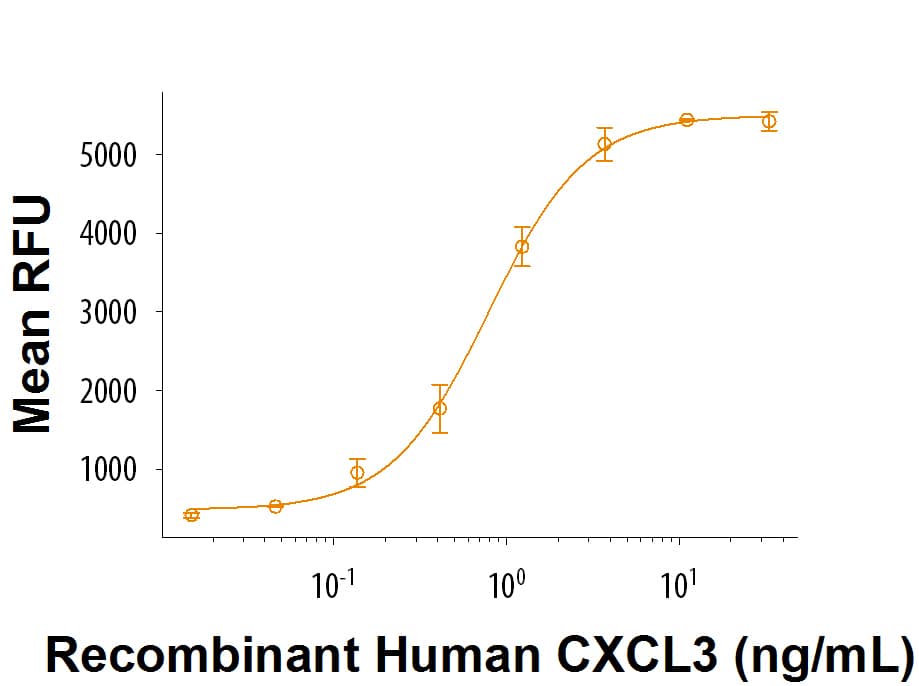Recombinant Human CXCL3/GRO gamma (aa 39-107) Protein
R&D Systems, part of Bio-Techne | Catalog # 8297-GG

Key Product Details
Product Specifications
Source
Thr39-Asn107
Purity
Endotoxin Level
N-terminal Sequence Analysis
Predicted Molecular Mass
SDS-PAGE
Activity
The ED50 for this effect is 0.4-2.4 ng/mL.
Scientific Data Images for Recombinant Human CXCL3/GRO gamma (aa 39-107) Protein
Recombinant Human CXCL3/GRO gamma (aa 39-107) Protein Bioactivity
Recombinant Human CXCL3/GRO gamma (Catalog # 8297-GG) chemoattracts BaF3 mouse pro B cells transfected with human CXCR2. The ED50 for this effect is 0.4-2.4 ng/mL.Formulation, Preparation and Storage
Carrier Free
What does CF mean?CF stands for Carrier Free (CF). We typically add Bovine Serum Albumin (BSA) as a carrier protein to our recombinant proteins. Adding a carrier protein enhances protein stability, increases shelf-life, and allows the recombinant protein to be stored at a more dilute concentration. The carrier free version does not contain BSA.
What formulation is right for me?In general, we advise purchasing the recombinant protein with BSA for use in cell or tissue culture, or as an ELISA standard. In contrast, the carrier free protein is recommended for applications, in which the presence of BSA could interfere.
Carrier: 8297-GG
| Formulation | Lyophilized from a 0.2 μm filtered solution in PBS with BSA as a carrier protein. |
| Reconstitution | Reconstitute at 250 μg/mL in sterile PBS. |
| Shipping | The product is shipped at ambient temperature. Upon receipt, store it immediately at the temperature recommended below. |
| Stability & Storage | Use a manual defrost freezer and avoid repeated freeze-thaw cycles.
|
Carrier Free: 8297-GG/CF
| Formulation | Lyophilized from a 0.2 μm filtered solution in PBS. |
| Reconstitution | Reconstitute at 250 μg/mL in sterile PBS. |
| Shipping | The product is shipped at ambient temperature. Upon receipt, store it immediately at the temperature recommended below. |
| Stability & Storage | Use a manual defrost freezer and avoid repeated freeze-thaw cycles.
|
Background: CXCL3/GRO gamma/CINC-2/DCIP-1
CXCL3, also known as Growth-regulated Oncogene gamma (GRO gamma), Macrophage Inflammatory Protein 2 beta (MIP-2beta), Dendritic Cell Inflammatory Protein 1 (DCIP-1), or Cytokine-induced Neutrophil Attractant 2 (CINC-2), is an 8 kDa pro-inflammatory member of the CXC subfamily of heparin-binding chemokines (1-3). Mature human CXCL3 (aa 35-107) shares 70% and 74% amino acid (aa) sequence identity with mouse and rat CXCL3, respectively. CXCL3 binds and activates CXCR2 to induce chemoattraction of CXCR2-expressing cells including neutrophils and endothelial cells (4, 5). Additional N-terminal processing of mature CXCL3 by the removal of aa 35-38 increases its chemotactic activity by several fold (6). In addition to binding CXCR2, CXCL3 can also bind and be sequestered by the Duffy Antigen Receptor for Chemokines (DARC) decoy receptor (7).
References
- Tekamp-Olson, P. et al. (1990) J. Exp. Med. 172:911.
- Haskill, S. et al. (1990) Proc. Natl. Acad. Sci. USA 87:7732.
- Zlotnik, A. and O. Yoshie (2012) Immunity 36:705.
- Strydom, N. and S.M. Rankin (2013) J. Innate Immun. 5:304.
- Mehrad, B. et al. (2007) Thromb. Haemost. 97:755.
- Wuyts, A. et al. (1999) Eur. J. Biochem. 260:421.
- Hansell, C.A. et al. (2011) Immunol. Cell Biol. 89:197.
Alternate Names
Gene Symbol
UniProt
Additional CXCL3/GRO gamma/CINC-2/DCIP-1 Products
Product Documents for Recombinant Human CXCL3/GRO gamma (aa 39-107) Protein
Product Specific Notices for Recombinant Human CXCL3/GRO gamma (aa 39-107) Protein
For research use only
